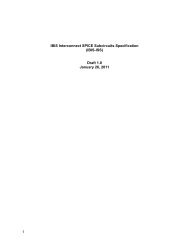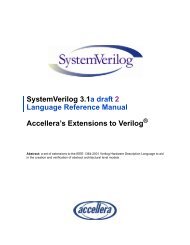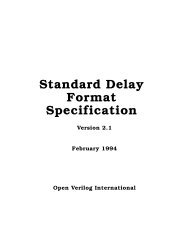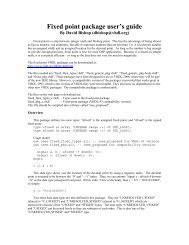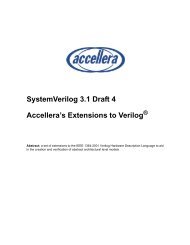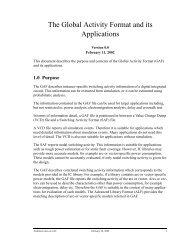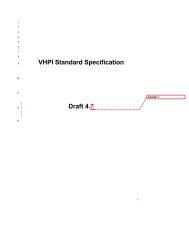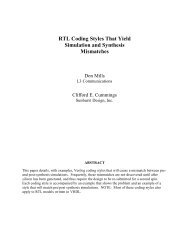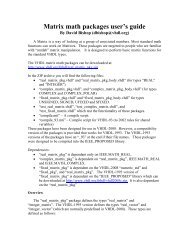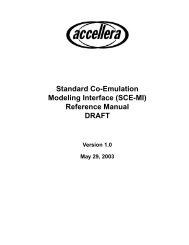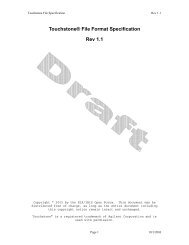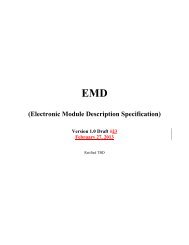Automated AMI Model Generation & Validation
Automated AMI Model Generation & Validation
Automated AMI Model Generation & Validation
Create successful ePaper yourself
Turn your PDF publications into a flip-book with our unique Google optimized e-Paper software.
<strong>Automated</strong> <strong>AMI</strong> <strong>Model</strong> <strong>Generation</strong> & <strong>Validation</strong><br />
Page 1<br />
DAC IBIS-Summit<br />
Anaheim, CA<br />
June 15 th , 2010<br />
José Luis Pino Agilent EEsof EDA<br />
Amolak Badesha<br />
Manuel Luschas<br />
Antonis Orphanou<br />
Halil Civit<br />
EEsof 2010
Agenda<br />
• <strong>AMI</strong> <strong>Model</strong> <strong>Generation</strong> Barriers<br />
• <strong>Automated</strong> <strong>AMI</strong> <strong>Model</strong>-generation flow<br />
Example-1: 6.25 Gb/s<br />
Example-2: 10.3125 Gb/s<br />
• TX <strong>Model</strong> Correlation Study<br />
Page 2<br />
-with Transistor Simulations<br />
-with Measurements<br />
• Benefits of <strong>Automated</strong> <strong>AMI</strong> flow<br />
EEsof 2010
#1 <strong>AMI</strong> modeling barrier<br />
<strong>Model</strong> <strong>Generation</strong> Time<br />
<strong>AMI</strong> <strong>Model</strong>ing suppose to Speed-up System Design Cycle,<br />
BUT, <strong>Model</strong>-generation takes Significant Time & Resources<br />
….System Vendors have to wait a LONG<br />
time before accurate <strong>AMI</strong> models become<br />
available<br />
Note: Vendors with NO experience in <strong>AMI</strong> modeling are spending 6-12+ months to<br />
come up with first-generation models<br />
Page 3<br />
<strong>Model</strong>s come very late in Design Cycle � used only for <strong>Validation</strong>, NOT Design<br />
EEsof 2010
Why <strong>AMI</strong>-model generation takes so long?<br />
Typical Signal Integrity Engineers are NOT programmers<br />
….they are having “Nightmares” in trying<br />
to develop <strong>AMI</strong> models<br />
• Cryptic Matlab/C++ code passed from System-Architectures � <strong>AMI</strong> <strong>Model</strong>er (if lucky)<br />
• Challenge to Convert Algorithm design Code � <strong>AMI</strong> format<br />
Page 4<br />
0 months<br />
Nightmare Begins<br />
<strong>AMI</strong> 101, Decipher Code<br />
4 months<br />
8 months<br />
Early <strong>Model</strong> prototypes<br />
First-model to Customer<br />
12 months<br />
EEsof 2010
Typical <strong>AMI</strong> model generation flow…<br />
Jan Feb Mar Apr May Jun Jul Aug Sep Oct Nov Dec<br />
Page 5<br />
Matlab/C++ <strong>Model</strong><br />
Compile C++ code<br />
C++ Code -> <strong>AMI</strong> (.dll, .ami)<br />
Channel Simulator <strong>Validation</strong><br />
EEsof 2010
<strong>Automated</strong> <strong>AMI</strong> model generation flow…<br />
Page 6<br />
EEsof 2010
ESL flow for <strong>Automated</strong> <strong>AMI</strong> <strong>Model</strong>ing<br />
Electronic System Level (ESL) design and verification is an emerging electronic design<br />
methodology that focuses on the higher abstraction level concerns first and foremost.<br />
ESL flow facilitates utilization of appropriate abstractions in order to increase<br />
comprehension about a system, and to enhance the probability of a successful<br />
implementation of functionality in a cost-effective manner<br />
Here is an Example of SerDes modeling using ESL flow-<br />
Page 7<br />
EEsof 2010
ESL flow: TX <strong>Model</strong>ing Example (1)<br />
Step-1: Starting Architecture Design with Generic <strong>Model</strong><br />
FIR/IIR filter<br />
Gain<br />
Different blocks represent high-level TX architecture<br />
n-tap<br />
FFE<br />
EEsof 2010
More on FIR Filter…<br />
How to bring in Spice or Measured data?<br />
Challenges:<br />
1. Typical Simulation and Measured Data is not equally time-stepped<br />
Low Sampling Rate<br />
FIR model should support<br />
“Arbitrary” Sampling Rate<br />
Sampling Rate determines Simulation Accuracy<br />
High Sampling Rate<br />
EEsof 2010
ESL flow: TX <strong>Model</strong>ing Example (2)<br />
Step-2: Customize IP -> Bring in Math Lang or C++ Code<br />
Fine-tune and Customize<br />
models with Math Lang<br />
and/or C++ code<br />
EEsof 2010
ESL flow: TX <strong>Model</strong>ing Example (3)<br />
Step-3: One-click <strong>AMI</strong> Code-<strong>Generation</strong><br />
One-click <strong>AMI</strong><br />
Code-generation<br />
Define Reserved and <strong>Model</strong> Specific Parameters -><br />
Automatically configure appropriate <strong>AMI</strong> wrapper<br />
EEsof 2010
ESL flow: TX <strong>Model</strong>ing Example (4)<br />
Step-4: Automatically Generated .ami and Visual-Studio project<br />
The visual studio project automatically<br />
created -> One click to create .dll<br />
EEsof 2010
Example #1<br />
6.0 Gb/s (SATA 3.0)<br />
Page 13<br />
EEsof 2010
TX <strong>Model</strong>ing<br />
6.0 Gb/s (SATA 3.0)<br />
TX Architecture<br />
Page 14<br />
FIR filter<br />
3-tap<br />
FFE<br />
EEsof 2010
RX <strong>Model</strong>ing<br />
6.0 Gb/s (SATA 3.0)<br />
RX Architecture<br />
Page 15<br />
S-domain<br />
filter<br />
3-tap<br />
DFE<br />
EEsof 2010
Results<br />
6.0 Gb/s (SATA 3.0)<br />
Page 16<br />
TX Output After Channel<br />
After CTLE EQ After CTLE+DFE EQ<br />
*Note: EQ taps not optimized for maximum eye<br />
EEsof 2010
Example #2<br />
10.3125 Gb/s (10-GB Ethernet)<br />
Page 17<br />
EEsof 2010
RX <strong>Model</strong>ing<br />
10.3125 Gb/s (10-GB Ethernet)<br />
Page 18<br />
EEsof 2010
Example #2<br />
10.3125 Gb/s (10-GB Ethernet)<br />
Page 19<br />
TX Output<br />
Channel Output<br />
RX Output<br />
EEsof 2010
TX 10.3125 Gb/s<br />
<strong>AMI</strong> model correlation study<br />
Strategy<br />
Page 20<br />
1. Correlate Transistor Simulation vs. <strong>AMI</strong> model<br />
2. Correlate Measured vs. <strong>AMI</strong> model<br />
EEsof 2010
Transistor Simulation vs. <strong>AMI</strong> <strong>Model</strong><br />
Steps-<br />
1. Generate Step Response from transistor simulation<br />
2. Generate <strong>AMI</strong> model using Agilent SystemVue<br />
3. Compare<br />
Page 21<br />
TX PKG PCB Cable<br />
EYE<br />
EEsof 2010
Step Response <strong>Model</strong><br />
Page 22<br />
Step Response from<br />
transistor simulation<br />
FIR filter with Step<br />
Response Input<br />
EEsof 2010
Correlation<br />
transistor model vs. <strong>AMI</strong> model<br />
Transistor<br />
<strong>Model</strong><br />
<strong>AMI</strong> <strong>Model</strong><br />
Excellent match between transistor simulation and <strong>AMI</strong> model<br />
Page 23<br />
Good faith in model-generation methodology!<br />
EEsof 2010
Measurement vs. <strong>AMI</strong> <strong>Model</strong><br />
Steps-<br />
1. Measure waveform<br />
2. De-embed Channel<br />
3. Output Impulse response<br />
Page 24<br />
EEsof 2010
Impulse Response <strong>Model</strong><br />
Page 25<br />
Impulse Response derived<br />
from Scope Measurement<br />
FIR filter with Impulse<br />
Response Input<br />
EEsof 2010
TX Correlation Measured<br />
emphasis #1: tap 0, 1, -0.2<br />
Page 26<br />
Measured<br />
<strong>AMI</strong> <strong>Model</strong><br />
EEsof 2010
TX Correlation Measured<br />
emphasis #2: tap 0, 1, -0.25<br />
Page 27<br />
Measured<br />
<strong>AMI</strong> <strong>Model</strong><br />
EEsof 2010
Benefits of ESL Design Flow<br />
<strong>Automated</strong> <strong>AMI</strong>-<strong>Model</strong> <strong>Generation</strong><br />
1. Complete “Automation” of Code-generation and <strong>Model</strong> Compilation<br />
a task that routinely takes months because of its complexity<br />
2. Basic building blocks that can used to start model development<br />
FIR/IIR filters, FFE, DFE, CDR etc.<br />
3. Easily customize models to include custom IP<br />
Custom C++ and Math-Lang<br />
Page 28<br />
EEsof 2010



